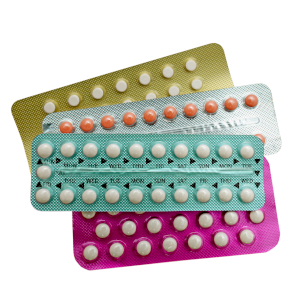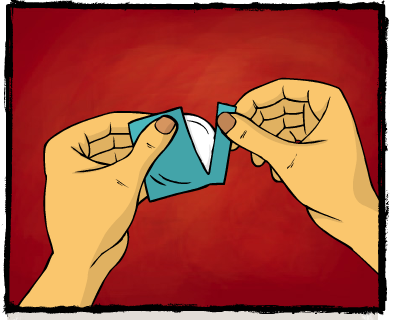
Safer sex means not allowing a partner's body fluids (blood, semen, vaginal fluids) into your body. It can also mean covering up parts of the body that might be infectious (e.g. herpes sores or warts) when engaging in sexual activity.
Safer sex
Safer sex means preventing the body fluids (blood, semen, vaginal fluids) of a sexual partner from entering into your body. It can also mean covering up parts of the body that might be infectious (e.g. herpes sores or warts) when engaging in sexual activity.
Having safer sex will protect your health and your partner's health by preventing STIs and unplanned pregnancy. It is important to use condoms and water-based lubricant when having sex including oral sex. Other ways to have safer sex include engaging in non-penetrative sex such as kissing, stroking and mutual masturbation that do not put a person at risk of an STI or unplanned pregnancy. Safer sex practices may be different for different people. It is important to know what safer sex practices are important for you, and to communicate these to your partner.
Teaching tips

- Before providing a lesson on safer sex, it would be helpful to review reproductive anatomy, menstruation and sperm production.
- Focus on the most commonly used contraceptive methods, such as abstinence, condoms and the pill, over methods such as withdrawal, sterilisation and IUD.
- Australia has no regulations about age requirements relating to youth obtaining contraception, including condoms.
- Be conscious of diversity within your student group, knowing that some cultures/religions do not approve of contraception.
- Emphasise that no assumptions are being made about students' sexual activity or experience.
- Ice-breaker activity idea - Ask students to name as many contraceptive methods as they can, including myths. Record these on the board, such as in the table below. Ensure that all myths are identified.
Contraception
There are several types of contraception available in Australia. Click on the following methods for more information.
*Note that since 2012, pharmacists have been able to supply oral contraception to patients without a GP script. Pharmacists can dispense pills to patients who have lost their script or are unable to see the doctor before their medication runs out.
| Hormonal | Barrier | Natural | Emergency |
|---|---|---|---|
Progestogen-only Mini-pill Combined hormones
| Spermicide Sterilisation | Abstinence Withdrawal method |
|
Condoms
Facts
- Male/external condoms are 85-98% effective.
- The use of condoms greatly reduces the risk of becoming pregnant and contracting an STI or BBV. It is essential for young people to know about them.
- Of the 2,000 Year 10, 11 and 12 students surveyed in La Trobe University's survey1, 34% reported having experienced sexual intercourse, i.e. 23% of Year 10, 34% of Year 11 and 50% of Year 121. The majority of these students reported using a condom the last time they had sex.
Condom teaching tips
- Young people need factual information about condoms but also the functional knowledge of where to buy them, how to use them, how to negotiate their use, etc. Decision making, negotiation and refusal skills, and opportunities to role play such skills, are essential.
- Students need to learn that condoms are not 100% effective. Viruses such as HPV (genital warts), herpes and syphilis can be transmitted if the condom does not cover all affected mouth or genital areas.
- Students need to know what to do in an emergency; for example, what to do if a condom breaks, and be aware of emergency contraceptive methods.
- Using flavoured condoms can help to emphasise the importance of safer sex practices during oral sex and may be more interesting to students and smell better than regular condoms.
- Sexual health education is for all - so it’s important to use language that includes same-sex attracted students. For example, use the term ’partner’ instead of boyfriend/girlfriend. According to the La Trobe survey1, the majority of the 2,000 students in the survey sample reported sexual attraction only to people of the opposite sex (83% of young men and 76% of young women), however 8% of young men and 4% of young women surveyed reported sexual attraction only to people of the same sex. Five percent of young men and 15% of young women reported that they were attracted to people of both sexes. Twelve percent of sexually active young men reported their most recent sexual encounter was with someone of the same sex as did 5% of sexually active young women.
Condom demonstration
 Students need to learn how to correctly use a condom. The Get the Facts website shows an animation of how to use a condom.
Students need to learn how to correctly use a condom. The Get the Facts website shows an animation of how to use a condom.
Rationale for condom demonstration
Doing a condom demonstration for your class and providing an opportunity for students to practise satisfies the 'Behavioural Skills' component of the IMB (Information, Motivation & Behaviour) model. Students may work in pairs or practise on their own using this method.
Another key activity is to have students practise assertive communication and decision-making skills in role play.
Relevant resources
Fact sheets/booklets/videos
Condoms and contraception, Get the Facts
How to use a condom animation, Get the Facts
Classroom resources
Categorising contraception SMARTBoard activity (SMARTTM Notebook software required)
Four categories are used to organise contraceptive methods in this activity. The categories help to explain characteristics of each type of contraception.



